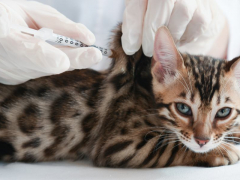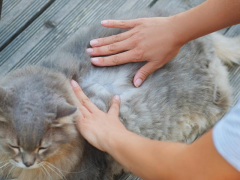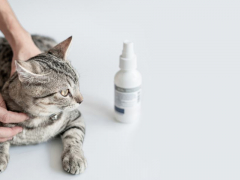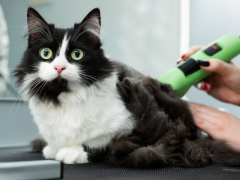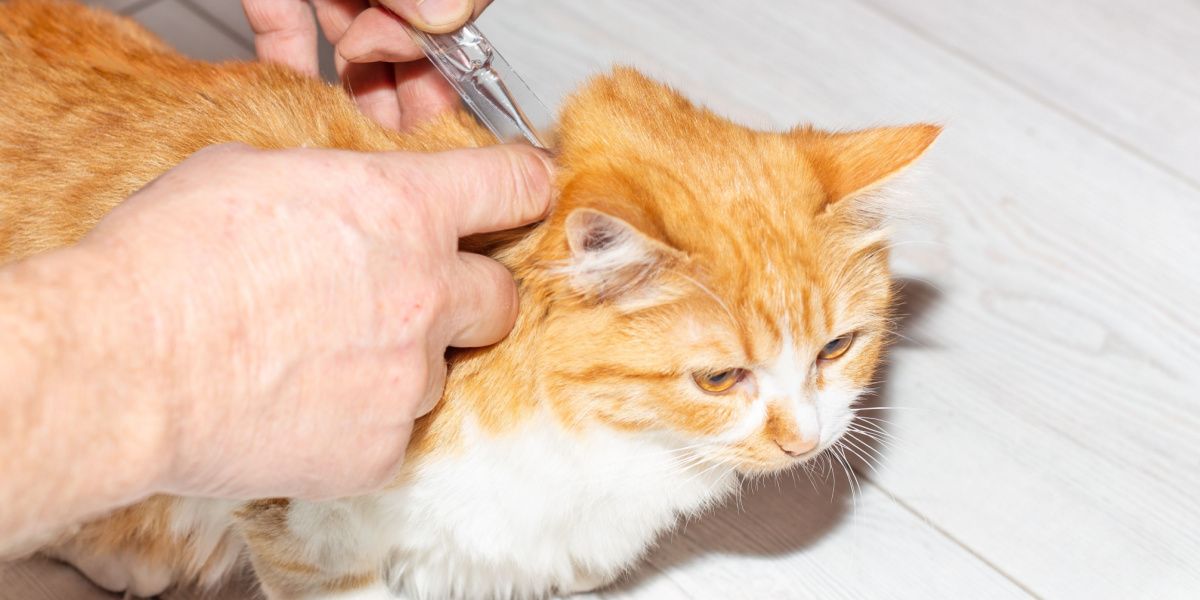
Owner applying antiparasitic drops to their cat’s fur. Shutterstock.com
Selamectin for cats is a topical medication applied to the skin. It works to kill and prevent certain external and internal parasites, including fleas, heartworm infection, ear mites, and intestinal worms. It is found in a range of common anti-parasite treatments.
In this article, you’ll learn how selamectin works, what parasites it is effective for, potential side effects to be aware of, and some frequently asked questions.
Selamectin for Cats

About Selamectin for Cats
Selamectin is an avermectin parasiticide designed to kill and prevent specific parasites. Selamectin is found in topical products applied to the skin. Revolution is the first brand that contained selamectin as an active ingredient and is the most recognizable. Now, there are several brands that contain selamectin in the US including Revolt, Selarid, Senergy, and Paradyne. Brands found in Canada include Selevectine and Evicto. In Europe, brands include Stronghold and Chanhold.
In cats, selamectin is indicated and FDA-approved for:
- Prevention and control of flea infestations (Ctenocephalides felis)
- Prevention of heartworm disease (Dirofilaria immitis)
- Treatment and control of ear mite infestations (Otodectes cynotis)
- Treatment and control of roundworm (Toxocara cati) and hookworms (Ancylostoma tubaeforme).
It is important to note that selamectin is one of the only products approved in cats for heartworm prevention.
Off-label use of products, where the product is not specifically licensed for this use but is widely adopted anyway, is very common in veterinary medicine. Selamectin has proven to be effective off-label for the treatment and control of various mite infestations, including notoedric mange (Notoedres cati), sarcoptic mange (Sarcoptes scabiei) and Cheyletiellosis (Cheyletiella).
Selamectin has a limited ability to kill and prevent ticks and control tick infestations. It is only indicated for treatment of the American dog tick (Dermacentor variabilis). Selamectin may also be found in combination products like Revolution Plus, which contains sarolaner, an ingredient that makes it much more effective for the treatment and prevention of ticks.
Selamectin works by enhancing the release of gamma amino butyric acid (GABA), a chemical involved in nerve conduction. By enhancing GABA release, selamectin causes paralysis and death of affected parasites. Some other intestinal worms like liver flukes and tapeworms do not use GABA, making selamectin ineffective against them.
Unlike most other topical products (such as fipronil), selamectin is absorbed systemically by the body after being applied to the skin. While pesky pests like fleas and mites can be killed by coming in contact with the skin of a cat treated with selamectin, it is important to note that selamectin products do not provide true repellency. According to Revolution’s label, the product can start killing adult fleas within 12 hours with a majority killed within 24 hours. It may take a couple of days for the full effects to be seen on a heavy infestation of fleas.
Dose for Cats
The recommended dose of selamectin for cats is fairly standard, even for generic products. Selamectin is approved for cats eight weeks of age and older. All body-weight dosing is based on the original label for Revolution for cats.
- Cats/kittens ≤ 5lb: 15mg vial
- Cats 5.1lb to 15lb: 45mg vial
- Cats 15.1lb to 22lb: 60mg vial
Selamectin products should be used every 30 days for the best protection.
Revolution is considered to be waterproof within 2 hours of application. However, the manufacturer recommends waiting 24 hours after applying selamectin to bathe a cat if possible. Applying to wet skin/fur or too soon after a bath will affect selamectin’s absorption by the body and therefore the effectiveness of the product.
How to Administer Selamectin to Cats
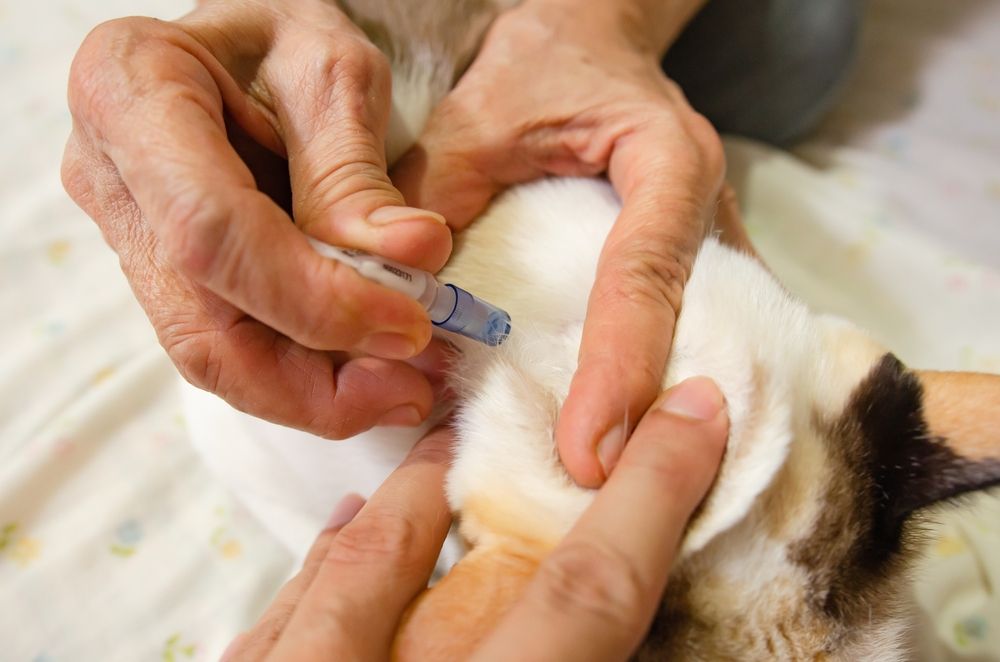
It is essential that the product is applied where it cannot be groomed or licked off by the cat, as it is not meant for ingestion. Shutterstock.com
Selamectin comes in many products, including those used in puppies and dogs. Always read instructions very carefully for any topical product prior to application, making sure the product is approved for use in cats, and for the correct weight band.
For the original Revolution product, open the blister pack and remove the small vial. The vial has a cap that must be pushed down to puncture the vial itself. The cap can then be removed and the entire contents of the vial applied to the skin.
The site of application should be the base of the neck/head, just in front of the shoulder blades. This area is the hardest for a cat to reach and greatly lowers the chance that the product can be licked off. The haircoat needs to be parted when applying so that the product is applied to the skin itself rather than the fur.
Application of a topical product is not typically stressful for a cat, though some cats may not like the sensation of the liquid application on the skin. Choose a time when your cat is calm, preoccupied, or resting. This may be on your lap, in a favorite snoozing location, or while eating a meal.
Side Effects of Selamectin for Cats
Selamectin products are typically safe when used as directed and side effects are uncommon. You may see some clumping of hair, stiff hair, or a slightly powdery residue after application—this is normal and temporary.
Topical products containing selamectin should never be ingested. Accidental ingestion from licking a product off may commonly lead to hypersalivation (drooling) and signs of vomiting. This is typically a bad taste response versus a true toxicity. The most common side effect reported during safety studies for Revolution was temporary hair loss at the treatment site. This occurred in about 1% of cats. Other side effects were seen in less than 0.5% of pets, including vomiting, diarrhea, and muscle tremors.
In 2021, post-approval experience data was released, which listed side effects reported to the FDA. It is important to note that when side effects are reported to the FDA, these may not always be directly attributable to a product. These are listed in decreasing order of frequency reported (the percentages themselves were not available):
- Application site reactions (hair loss, redness (hives), pruritus (itching), inflammation, blisters, excoriations, hair discoloration)
- Lethargy
- Lack of appetite/anorexia
- Vomiting
- Death
- Generalized itching
- Poor balance/incoordination/ataxia
- Fever
- Generalized hair loss
- Tremors
- Excessive drooling
- Skin redness/erythema and inflammation
- Seizures
A mutation in the MDR1 gene in dogs was discovered in 2001, which makes some dogs have serious adverse reactions to medications including avermectins like selamectin. In early 2022, researchers at Washington State University also discovered this same mutation in cats. Unlike in dogs, no breed predisposition has been found in cats, but the prevalence of the mutation is thought to be about 4% of the cat population, including about 4 million cats in the US. Cats with this mutation may have more serious adverse reactions to selamectin products, including seizures, tremors, and death. The mutation also affects reactions to several other types of medications. WSU does have testing available to detect the gene mutation.
Overdose and Emergencies
If you are ever concerned that your kitty may have developed side effects while using a selamectin product, if ingestion of the product is suspected, or if the wrong size of vial is applied, immediately contact one or more of the following for advice:
- Your veterinarian
- ASPCA Animal Poison Control Center (1-888-426-4435)
- Pet Poison Helpline (1-855-764-7661)
Selamectin products can cause irritation of the skin and eyes in people. Make sure to wash your hands after applying the product to your cat.
Potential Drug Interactions With Selamectin

Selamectin can be used alongside other preventative care measures, including other anti-parasite treatments. Shutterstock.com
No drug interactions have been documented with selamectin. During clinical studies for Revolution, selamectin was used safely with vaccines, deworming products, other anti-parasitics, antibiotics, steroids, soap, shampoos, and dips (used for external parasite treatment).
Selamectin alone has limited tick control capability. However, the more recent addition of Revolution Plus, which has better tick control, has reduced the need to give cats two separate topical products if tick control is a concern.
Drug Dosing Disclaimer: We are only able to provide doses for medications that are FDA approved for use in cats and only as the label guidelines dictate. For medications that are used off-label we can only provide guidelines and safety information for use. Safe and appropriate dosing for off-label medications can only be determined by a primary care veterinarian.
We encourage you to work with your veterinarian to determine if a particular medication is appropriate for your cat. Changing or adjusting a dose for your cat on your own without consulting with a veterinarian can carry risk. We do not encourage use of medications prescribed for human use in pets without first consulting with a primary care veterinarian.
-
A.F. Vatta et al. Efficacy of a new topical formulation containing selamectin plus sarolaner against three common tick species infesting cats in the United States. Vet Parasitol. 270, Suppl 1, pp S19-S25 (2019). https://www.sciencedirect.com/science/article/pii/S0304401718303509
-
Chailleux N, Paradis M. Efficacy of selamectin in the treatment of naturally acquired cheyletiellosis in cats. Can Vet J. 2002 Oct;43(10):767-70. PMID: 12395757; PMCID: PMC339606. https://www.ncbi.nlm.nih.gov/pmc/articles/PMC339606/
-
D.J Shanks et al. The efficacy of selamectin in the treatment of naturally acquired aural infestations of Otodectes cyanotis in dogs and cats. Vet Parasitol. 91, 3-4, pp 283-290. (2000).
-
Becskei C, Reinemeyer CR, King VL, Lin D, Myers MR, Vatta AF. Efficacy of a new spot-on formulation of selamectin plus sarolaner in the treatment of Otodectes cynotis in cats. Veterinary Parasitology. 2017;238:S27-S30. doi:10.1016/j.vetpar.2017.02.029
-
EVICTO selamectin topical solution (45 mg) for Cats (Canada). Drugs.com. https://www.drugs.com/vet/evicto-selamectin-topical-solution-45-mg-can.html
-
Paradyne for animal use. Drugs.com. https://www.drugs.com/vet/paradyne.html
-
Revolt (selamectin) for Animal Use. Drugs.com. https://www.drugs.com/vet/revolt-selamectin.html
-
Revolution Topical Flea Treatment for Dogs/Cats. Drugs.com. https://www.drugs.com/pro/revolution-topical.html
-
Selarid (selamectin) for Animal Use. Drugs.com. https://www.drugs.com/vet/selarid-selamectin.html
-
Selavectine (45 mg) for Cats (Canada). Drugs.com. https://www.drugs.com/vet/selavectine-45-mg-can.html
-
Senergy (selamectin) for Animal Use. Drugs.com. https://www.drugs.com/vet/senergy-selamectin.html
-
Fisher M, Shanks DJ. A review of the off-label use of selamectin (Stronghold®/Revolution®) in dogs and cats. Acta Veterinaria Scandinavica. 2008;50(1). doi:10.1186/1751-0147-50-46
-
Gollakner, R. Selamectin. VCA Animal Hospitals. Accessed September 14, 2023. https://vcahospitals.com/know-your-pet/selamectin
-
Merola, V. and Dunayer, E. Toxicology Brief: The 10 most common toxicoses in cats. DVM360. 2006. Accessed September 14, 2023.
-
Toxicology Brief: The 10 most common toxicoses in cats. DVM 360. https://www.dvm360.com/view/toxicology-brief-10-most-common-toxicoses-cats. Published April 27, 2020.
-
M.J. Krautmann et al. Safety of selamectin in cats. Vet Parasitol 91, 3-4, pp 393-403. (2000).
-
Krautmann MJ, Novotny MJ, De Keulenaer K, et al. Safety of selamectin in cats. Veterinary Parasitology. 2000;91(3-4):393-403. doi:10.1016/s0304-4017(00)00307-1
-
Revolution (selamectin) [package insert]. Zoetis Inc.
-
REVOLUTION® (selamectin) Topical Parasiticide For Dogs and Cats https://www.zoetisus.com/content/_assets/docs/Petcare/Revolution-Prescribing-Information.pdf
-
Sarasola, P., Jernigan, A.D., Walker, D.K., Castledine, J., Smith, D.G. and Rowan, T.G. (2002), Pharmacokinetics of selamectin following intravenous, oral and topical administration in cats and dogs. Journal of Veterinary Pharmacology and Therapeutics, 25: 265-272. https://doi.org/10.1046/j.1365-2885.2002.00415.x
-
Williams, K. Selamectin + Sarolaner Topical. VCA Animal Hospitals. Accessed September 14, 2023. https://vcahospitals.com/know-your-pet/selamectin--sarolaner-topical
